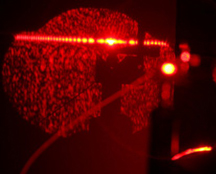

Tweet
New Laser Technique Measures Complex Interactions
By David Salisbury and Mika Ono
A new laser technique has demonstrated it can measure the interactions between proteins tangled in a cell's membrane and a variety of other biological molecules. These extremely difficult measurements can aid the process of drug discovery.
Scientists estimate that about 30 percent of the 7,000 proteins in a human cell reside in the cell's membrane, and that these membrane proteins initiate 60 to 70 percent of the signals that control the operation of the cell's molecular machinery. As a result, about half of the drugs currently on the market target membrane proteins.
"Many, if not most, of the proteins of interest are anchored in cellular membranes," said Scripps Research Professor M.G. Finn.
Despite their importance, these membrane proteins are difficult to study. Individual membrane proteins are extremely hard to purify, so scientists have very little structural information about them. In addition, existing methods to measure their activity have serious limitations. Most existing assays remove the membranes from their natural environment or modify them in a variety of different ways, such as attaching fluorescent labels, in order to analyze membrane protein activity. Not only are these modifications expensive and time-consuming, they also can affect the function of the target membrane in unpredictable ways.
By contrast, in an article published online March 13, 2011, by the journal Nature Biotechnology, Finn, Vanderbilt Professor Darryl Bornhop, and colleagues report that a laser-based technique, called backscattering interferometry (BSI), can precisely measure the binding force between membrane proteins and both large and small molecules in a natural environment—without tagging the membrane-bound protein or the binding agent in any way.
"We anticipate that this method will enable the rapid exploration of much fundamental biochemistry," said Finn, "as well as drug discovery involving membrane protein targets."
Lasers Aid Measurement
BSI is deceptively simple. It measures the binding force between two molecules mixed in a microscopic liquid-filled chamber by shining a red laser like those used in barcode scanners through it. When the geometry of the chamber is correct, the laser produces an interference pattern that is very sensitive to what the molecules are doing. If the molecules begin sticking together, for example, the pattern begins to shift.
In the new study, the researchers created synthetic membranes that contained a small protein, called GM1, that is a primary target that cholera toxins bind with in order to get into a cell. When they mixed these membranes with cholera toxin B, they measured a binding force consistent with that obtained by other methods.
The researchers performed similar validation tests with naturally derived membranes and three membrane proteins, one associated with breast cancer, another associated with pain and inflammation and the neurotransmitter GABA known to aid in relaxation and sleep and to regulate anxiety.
When they mixed the membranes containing each of these proteins with molecules known to bind with them, the BSI technique provided measurements that agreed with the values obtained by other methods, the scientists reported.
The first author of the paper, "Label-free quantification of membrane-ligand interactions using backscattering interferometry," is Michael Baksh of Scripps Research. In addition to Finn, Bornhop, and Baksh, authors of the paper include Amanda Kussrow of Vanderbilt and Mauro Mileni of Scripps Research. For more information, see http://www.nature.com/nbt/journal/vaop/ncurrent/abs/nbt.1790.html .
The research was funded by the National Institutes of Health, Joint Center for Innovative Membrane Protein Technologies, the Skaggs Institute for Chemical Biology, and the Molecular Basis of Viral Pathogenesis Training Program.
Send comments to: mikaono[at]scripps.edu

A new technique called backscattering interferometry could enable the rapid exploration of fundamental biochemistry, as well as drug discovery involving membrane protein targets, according to Scripps Research Professor M.G. Finn. This image shows patterns created by a red laser. (Daniel Dubois / Vanderbilt)
